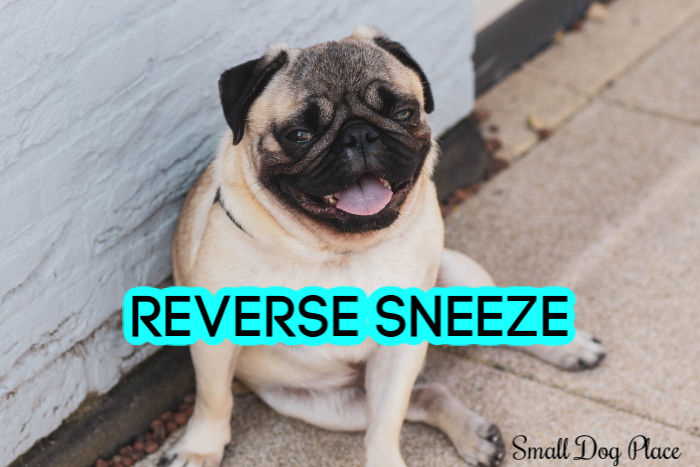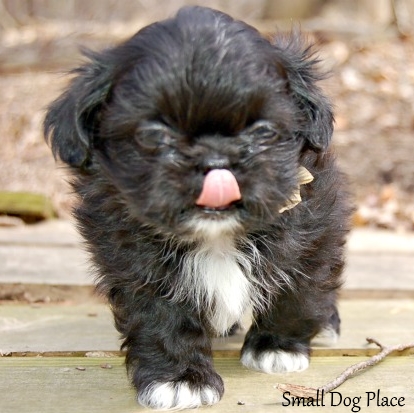- Home ›
- Health ›
- Reverse Sneeze
Reverse Sneeze:
Should You Worry?
By Janice Jones |Last Updated November 22, 2021
A reverse sneeze is a common occurrence in some dogs, especially brachycephalic breeds and small dogs and can sound menacing and even give the impression that the dog is choking or worse.

Causes of Reverse Sneezing
Owners unaware of the problem can rush their dog off to the emergency veterinarian thinking the dog is about to die. But relax, it sounds worse than it is.
The medical term for Reverse Sneezing pharyngeal gag reflex or paroxysmal respiration. The dog sounds like he is trying to inhale his sneeze! In reality, it is caused by a spasm in the throat and soft palate that is triggered by an irritant.
This honking cough sound occurs when the dog inhales and exhales air quickly. Often it results when a dog has a minor post nasal drip or some other minor irritant at the back of the throat.
People cough to “clear their throat” but dogs honk. This can be a frequent occurrence especially in dogs that suffer from allergies. Dogs can be allergic to dust, pollens, cigarette smoke, household cleaners, and even human perfumes.
Causes
- Environmental irritants
- Allergies
- Rapid Change in temperature as in going in or outside
- Pulling on a leash
- Strenuous exercise
- Eating/Drinking too fast
- Excitement
- Too tight collar
- Nasal mites
You might even notice your dog doing this frequently when the temperature drops or rises suddenly. For example, this can happen when your dog first comes indoors during a cold winter day. The drastic change in temperature triggers the spasm.
Other dogs may eat or drink too fast and fall into an episode of reverse sneezing.
Another cause that can trigger a spasm occurs when the small dog is pulling on a leash attached to the collar. Walking a small dog wearing a harness is much safer. The pressure that the collar exerts on the throat can bring on the honking sound.
Small dogs have a tendency to run around wildly at times and the very act of running wildly, though blissful to them, may trigger a reverse sneeze.
How do I know if my dog is having a reverse sneeze?
- People who are unfamiliar with the sound might think their dog is having
a seizure, gasping for air, or about to die.
Luckily, this is a harmless event and especially common in brachycephalic
dogs such as the pug, Shih Tzu, Boston terrier, and Lhasa Apso. It is more
common in small breed dogs, possibly because they have smaller throats, but it can happen in any size
dog.
- Reverse sneezing is not really a health problem, and the whole episode may last for less than two minutes. You should not confuse this with a more serious condition called Tracheal collapse, which does require medical attention.
- The reverse sneezing is not the same as an actual sneeze, but it is not dangerous. Dogs do not pass out during reverse sneezing, and they do not collapse, however, they can last from a few seconds to a minute or more. This can make the entire episode scary for a concerned dog owner.
- Honking, hacking, or snorting sounds are the most characteristic noises of a reverse sneeze. The dog may extend his/her neck while standing with elbows extended. One way you will know for sure if it is a reverse sneeze or something else is to perform the simple maneuver described below.
The sounds that a dog makes during a reverse sneeze is unforgettable and once you've heard it once, you'll be able to recognize it in any dog.

Treatment
Luckily, the cure is painless and very cheap. What should you do? You can usually stop a reverse sneeze easily in your small dog. To stop a reverse sneeze:
- Gently rub the throat of your dog. The spasms will cease after they swallow, and
that is the end of it.
- If that does not work, take your dog outside for
some fresh air.
- Another option that works well is to cover your dog’s
nose, so that he is forced to breathe through his mouth.
- If you trust your dog not to bite you, you can try to
open his mouth and press on his tongue.
This opens the airways and stops the spasm.
- If all else fails, cover his nose and gently massage his throat. This last method will stop the episode.
What if I do nothing?
Don’t worry if you choose not to do anything to stop the spasm. They will cease on their own.
When Should I Worry?
If reverse sneezing becomes a chronic condition, occurring frequently, or lasting longer, you may want to make an appointment for the dog to be checked out.
There may be other problems that are causing the irritation such as tumors, nasal mites, a kennel cough or respiratory tract infection or even collapsing trachea.
Sometimes treating the allergy is all that is needed to reduce the incidence, but you will never know unless you get your dog to the veterinarian.
Is there anyway to prevent reverse sneezing from occurring?
Since the major culprit of reverse sneezing is some type of environmental irritant, the best way to prevent the problem is to remove as many irritants from the air as possible. But, that is easier said than done.
Here are a couple of suggestions that might help.
- Don't smoke around your dog
- Avoid products such strong perfumes and cleaning chemicals that leave strong odors around the home.
- Use air conditioning, replace air filters and leave windows closed especially on windy days.
- Vacuum frequently and use a hepa filter to trap particles in the air.
- Teach your dog not to pull on the leash when you are out-and-about.
References and Further Reading
About Janice (author and voice behind this site)
Having lived with dogs and cats most of her life, Janice served as a veterinary technician for ten years in Maryland and twelve years as a Shih Tzu dog breeder in Ohio.
Her education includes undergraduate degrees in Psychology with a minor in biology, Early Childhood Education, and Nursing, and a master's in Mental Health Counseling.
She is a lifelong learner, a dog lover, and passionate about the welfare of animals. Her favorite breed for over 50 years has been the Shih Tzu, but she has also lived with poodles, Maltese, Yorkshire Terriers, beagles, English bulldogs, carin terriers, and a Cocker Spaniel.
When not writing, reading, and researching dog-related topics, she likes to spend time with her eight Shih Tzu dogs, husband, and family, as well as knitting and crocheting. She is also the voice behind Miracle Shih Tzu and Smart-Knit-Crocheting
Does This Article Deserve Your Thumbs Up?
We always appreciate your support and encouragement. Your thumbs up means so much to us. Please like this article.
If you find this page or any page on Small Dog Place Helpful, or useful in anyway, I'd love it if you would click the small heart found on the bottom right of each page.
You can also share or bookmark this page -- just click on the:

Free Monthly Newsletter
Sign Up for Our Free Newsletter and get our Free Gift to You.
my E-book, The Top 10 Mistakes People Make When Choosing a Dog (and how to avoid them)






